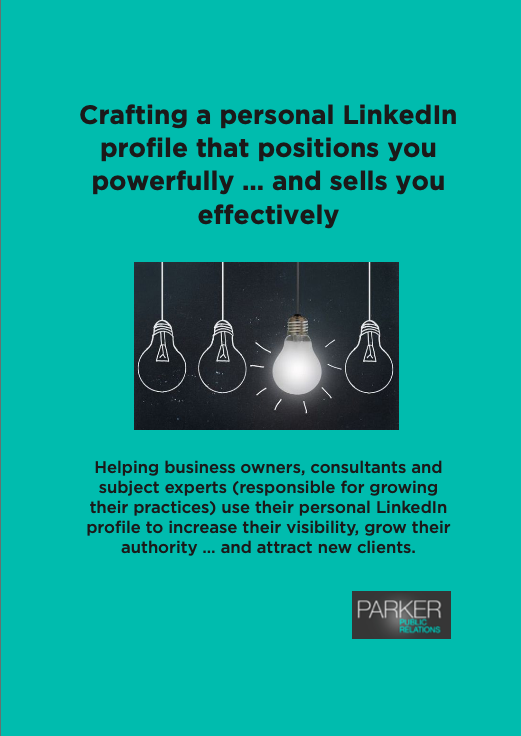LinkedIn is easily one of the most effective channels for positioning yourself and enhancing your reach as a thought leader.
But rather than attempting to reinvent the wheel, I have dipped into the treasure trove of information provided by ChristineHueber.com who is without a doubt a true ‘Jedi Master’ of LinkedIn.
Before I begin extracting their pearls of wisdom (along with a few of mine and those of my thought leadership business partner, Trudy Rankin,) a quick recap of what thought leadership is. According to Joel Kurtzman, the man who coined the term back in 1994, thought leaders are those whose ideas ‘merit attention’.
These people have earned their stripes in their field or devoted their careers to researching their special interest topic and have the education to support their expertise.
They also have a vision for the future, keep an eye on developing trends and anticipate how today’s actions will impact tomorrow’s results. They also have the wherewithal and leadership to inspire people to act and take their thinking and ideas further.
How to position yourself as a thought leader
That doesn’t, of course, include saying you are a thought leader. That is an absolute no-no. Only others can bestow that moniker on you. It is never something you call yourself!
If you want to build your thought leadership platform, here are FOUR ways to leverage LinkedIn to get started:
Create the perfect thought leadership profile
Ensure your background, headshot, headline, summary, experience and interests position you as a thought leader.
Also check on the following:
- Does your custom background tie in with your brand?
- Is this consistent with other online collateral such as website and other social media platforms?
- Does your headshot engage your ideal audience? Is it compelling to them? For example, if you’re a start-up tech professional, you’d likely have a different headshot than if your ideal audience were corporate attorneys.
The top portion of your profile is your first chance to grab attention and powerfully position yourself as a thought leader and expert. You have 120 characters in your headline and 2,000 in your summary. Make the most of this valuable real estate that shows up in search results by maximizing your keywords and using a call-to-action. Write your summary as a sales page, not a resume. Engage your viewers and make taking the next step with you compelling. Lead them on a journey with your story.
Remember, your profile always appears in Google search results for your name.
LinkedIn will also want some proof that you’re a true leader. Once you have beefed up your profile and have a thorough summary and list all of your previous experience, pay special attention to the Skills & Expertise, Honours & Awards and Recommendations sections.
Be sure you have been endorsed for all of your skills many times. That said, only include the top 4-6 skills that position you as a thought leader in your field and which you want to be known for.
A word of warning: only ask for or accept recommendations from people who truly know what you are capable of.
According to Trudy Rankin, a recommendation is more powerful than an endorsement so a good way of building your number of recommendations would be to reach out to other existing or emerging thought leaders in other areas (preferably people who have been positively influenced by you) and get them to write you a recommendation.
Join relevant groups
Use the search field on the top left of the LinkedIn website. Start with keywords like “leadership,” for example, and select groups from the drop-down menu. Join all the groups that are relevant to get visibility and access to members (give yourself a maximum of 100.) Use the LinkedIn share icon to send articles to all your groups with a single click.
Be sure to follow thought leaders in your industry too, like Elon Musk or Guy Kawasaki.
Create the right kind of content for your posts
To position yourself as a thought leader, your posts need to be timely, relevant and forward thinking.
Timely content. Here’s the simple definition of timely content; it’s something your audience can use NOW. Whether it’s something that can help them with an immediate situation or something which can prepare them for tomorrow’s challenges. Timely content is a gift to your audience.
Audience Relevance. Thought leaders know how to take any piece of information and make it relevant to their audience. This is why story telling is so important. It allows your audience to be captivated through the story, but still delivers a powerful and relevant message.
Forward Thinking. Forward thinking is the foundation of thought leadership. It’s the ability to distill information through your past experiences and gut instinct, which allows you to make predictions on the future. But forward thinking also requires risk. You’ll be walking down an uncharted path filled with haters and naysayers. But stick with your vision and your gut if you know it’s the right thing to do.
Provide additional value when you share articles
To further enhance your expert status, when sharing an article ensure you add your own comment, regardless of whether the piece is from Harvard Business Review or Forbes. Never share without providing your own pearls of wisdom.
Your commentary could point to the value and importance of the piece. Alternatively, it could be your opportunity to create debate or provide a brand new or opposite perspective.
If you are interested in learning more about thought leadership, Parker Public Relations provides ongoing mentoring and coaching or you can book into one of our regular two-hour workshops.
Let us know if you are interested in coaching or a workshop. To get in touch, click here, or contact Wendy at wendy@parkerpublicrelations.com.au


